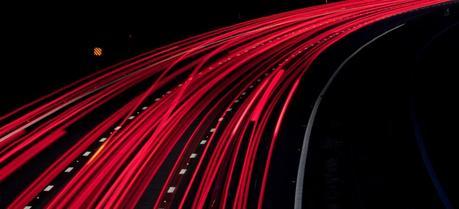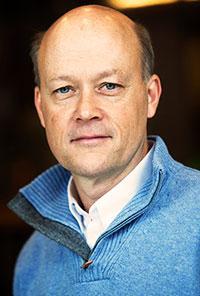 An electric road will consist of a large number of electrically conductive tapes—like the light trails on a night road. (Credit: Flickr @ Michael Rammell http://www.flickr.com/photos/mikerammell/)
An electric road will consist of a large number of electrically conductive tapes—like the light trails on a night road. (Credit: Flickr @ Michael Rammell http://www.flickr.com/photos/mikerammell/)European scientists and engineers are working on a technology that would allow to charge an electric car on the go. A network of “smart power supply” could make it possible to drive an electric car all day without having to recharge.
“We have the technology to power a car while it is moving, with an electrical track in the road that propels the car in a way that’s a lot like a slot-car kit,” says Mats Leksell, a senior research engineer in Energy Conversion at the KTH School of Elecrical Engineering and leader of the Electrical Roads project.
But unlike a toy, an electric car has a battery that enables it to continue driving independently of the road’s power supply, when it needs to overtake another vehicle or simply leave the electrified road entirely, he says.
Together with a start-up company called Elways ab, Leksell’s team has been testing the technology on an electrical demonstration road close to Arlanda, Stockholm’s international airport. The involvement in electrical roads evolved from hybrid vehicle research that began nearly ten years ago at KTH EE. “We lifted our eyes from the vehicles and began to think about the entire transportation infrastructure,” Leksell says.
As the car enters the section of pavement where the strip lies, an arm drops from beneath the vehicle, finds the electrical track, and locks in. “It’s similar to the third rail on a subway line, only it can be confined and made difficult for people to actually touch,” he says. “Safety is crucial.”
The team has examined other practical questions, such as how to keep the track from freezing or icing over (the rail can be heated), or how the connection should work (the team is testing materials and techniques for connecting and disconnecting a car from the grid).

Mats Leksell, senior research engineer at Electrical Energy Conversion. (Credit: Janne Danielsson)
“The technology for this already exists,” Leksell says. “For now it’s more of an infrastructure problem to work out.” Discussions with the nation’s power utilities and transportation ministry indicate that Sweden is probably about ten years away from implementing electrified roads between its major cities, Leksell says. The roads less travelled will be left powerless, however. Leksell says that since the idea is to use energy efficiently, only routes with high traffic volumes will be considered.
Frequent traffic will improve the economics of electrification and ensure that power doesn’t go to waste.
The Electrical Roads concept addresses the major flaw in the electric-car solution for reducing greenhouse gases. “We really have no practical storage capacity for electric cars,” Leksell says. “Fossil fuels are an excellent means of storing energy, but they took millions of years to develop. Batteries don’t hold nearly as much energy. They’re big and heavy and take a long time to charge.”
And besides, “electricity is a commodity that should be digested immediately,” Leksell says.
Sweden could be a leader in the electrification of roads because its electrical grid is not dependent on fossil fuels. “We don’t just shift the combustion from the vehicle to a coal-powered plant, so the carbon footprint will be reduced substantially,” he says.
Leksell says that if cars are to be part of the solution to global warming, they cannot be viewed in isolation from the rest of the world’s energy problems. He envisions an “internet of electricity,” which connects all consumers with a variety of green energy sources: solar from the Sahara, hydropower from the north of Sweden, and wind and wave power from open waters.
A recent call for proposals from the eu’s initiative on electromobility could allow KTH solutions on electrical roads to be compared with others currently in development for mass deployment.
But engineering is only one dimension of the overall solution. A PhD student in the industrial economic programme is now investigating different business models aimed at making the concept economically feasible.
“That’s the big question mark for everyone: How do you distribute the costs?” Leksell says. “This is a case where the technology is ahead, and now society has to figure out how to incorporate it.”
Original article by David Callahan

